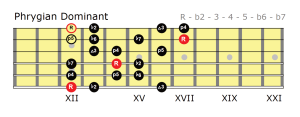The fifth mode of the Harmonic Minor scale is Phrygian Dominant. A pretty evocative sounding mode that reminds you strongly of Spanish gypsy music. Use of the term “dominant” should be a clue here to some of the intervals: it has a major 3rd and flattened 7th.
This mode is also known as Phrygian major or altered Phrygian. Also Spanish Gitan or Spanish Gipsy scale.
Note that the Berklee method unifies the natural minor (Aeolian) and harmonic minor scales to produce an 8 note composite minor scale (effectively becoming Aeolian with a leading note). The fifth mode of the composite minor scale is known as as the Mixolydian b9 #9 b13.1 Looking at Phrygian Dominant, it could be said to be Mixolydian b9 b13.
Scale formula
The formula for the Phrygian Dorian scale is:
R - b2 - 3 - 4 - 5 - b6 - b7
You can see this scale is similar to the major scale Phrygian mode, the only difference being the major 3rd.
Chords
- Dom7
- Dim7
Usage
This mode of Harmonic Minor is strongly dominant, with an exotic, Eastern, and Spanish flavour due to the ♭2 and ♭6. The major 3rd makes Phrygian Dominant function as a dominant (V) mode, unlike standard Phrygian, which is minor.
Since Phrygian Dominant is built on the 5th degree of the Harmonic Minor Scale, it is best used over dominant 7 chords, especially in V → i progressions, that is when resolving to minor.
Phrygian Dominant is the defining sound of Flamenco music. Phrygian Dominant emphasizes the ♭2 and ♭6 which gives it that strong Spanish flavor. It is also found in Arabic, Persian, and Indian music.
Neoclassical guitarists like Yngwie Malmsteen and Ritchie Blackmore use Phrygian Dominant extensively. It is something of a staple in modern metal riffs too. \m/
References
- Mulholland and Hojnacki (2013), The Berklee Book of Jazz Harmony, p94-p95.

